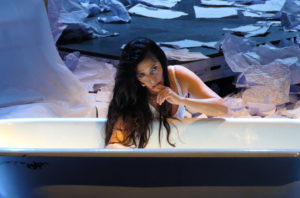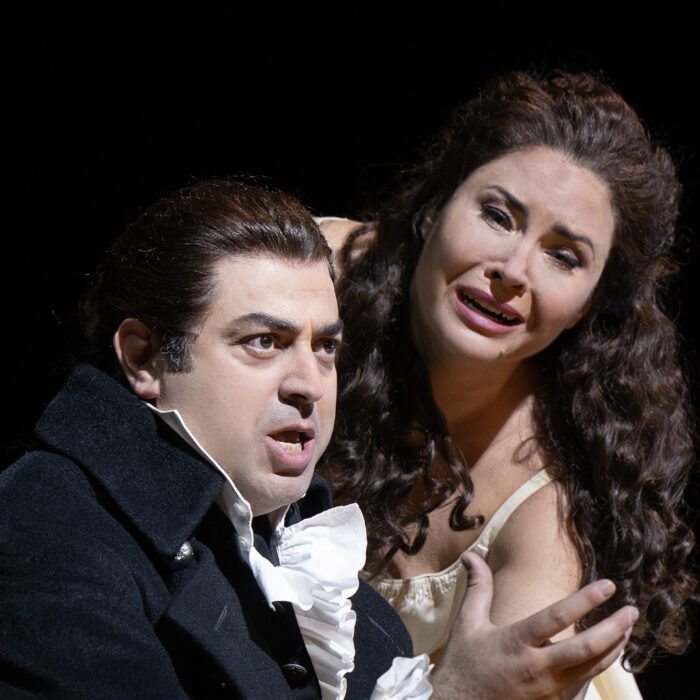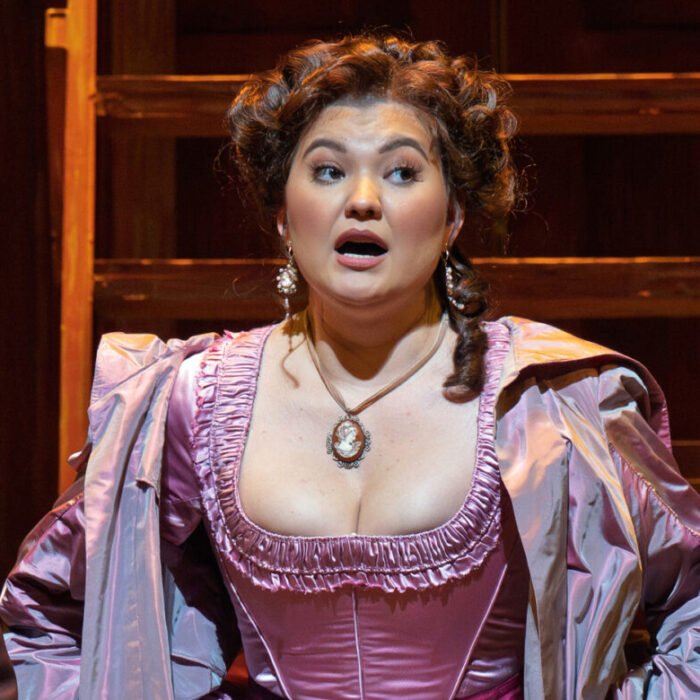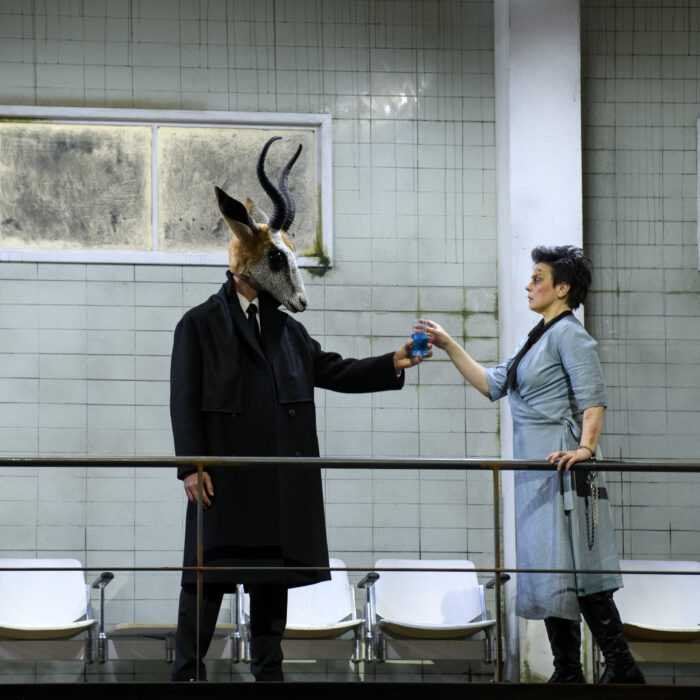
The Haydn Foundation 2021 Review: Carlota Zimmer
Johanna Vargas Produces A Compelling Picture Of Obsession & Mental Collapse
By Alan Neilson(Photo: Naomi Eleonora Biagi)
With its commitment to producing contemporary works, The Haydn Foundation situated in Bolzano under the artistic direction of Matthias Lošek, must have one of the most ambitious opera programs in Italy, if not Europe. Over the past few years, it has consistently promoted and commissioned new pieces which it intersperses with thematically linked known works. It is a brave approach; selling contemporary opera is never easy, regardless of the fact that the works are often of high quality.
We have reached a strange state of affairs in which opera companies throughout the world are often content to regurgitate the same fare season after season which, to a large extent, is centered on well-worn 19th century compositions. It is, of course, understandable, as it is what the audience wants, isn’t it? Some composers working during the mid to latter part of the 20th century, however, can be held partly responsible for this situation as their often self-indulgent experimentation and disregard for the tastes of the audience drove them into a musical cul-de-sac, and created the common perception that contemporary opera is remote and largely inaccessible.
Yet, this is no longer the case. On the contrary, contemporary opera tends to be very accessible. Not only does it engage with the issues, frustrations, hopes, and preoccupations of current audiences, but it does so with a 21st century mindset; it talks to us directly, in the same way for example, “La Traviata” engaged with a 19thcentury audience about tuberculosis and the position of the courtesan in society. Moreover, many composers seem to have learned the lessons of the past; while they may not have completely abandoned their experimental sound and structural techniques, they now employ them with greater refinement, more clearly pointed at serving the dramatic goals of the drama. At the same time, there has been a greater emphasis on reintegrating into the mix the recognizable traditional musical structures of the past. Many composers also enjoy creating multimedia works in which video and computer imaging perform an important role. Contemporary opera is now a very diverse genre and has more to offer an audience than it has done for many years. But this will count for little unless opera companies start to turn over a greater part of their program to performing them. So The Haydn Foundation’s stance is a most welcome one, and certainly deserving of support.
Its season, like so many other companies, was badly affected by the measures aimed at controlling COVID-19. During the month of June, however, it managed to put together a short program of three staged works, the third of which was “Carlotas Zimmer” by the Mexican composer Arturo Fuentes.
The Belgium Princess
Carlota was a Belgian princess who married Maximiliano, the brother of the Austrian Emperor Franz Josef. After accepting the Mexican crown, the couple found themselves involved in a civil war with republicans, in which Maximiliano was captured and executed. Meanwhile, Carlota had returned to Europe in order to find help for her husband. On hearing the news of his death she retired to Miramare Castle near Trieste where she spent most of the rest of her life in solitude, staring out over the sea, obsessed by memories of her dead husband, to whom she wrote a continuous stream of passionate letters, and descended into a state of madness. She eventually returned to Belgium, where she died in 1927, the year Lindbergh flew non-stop across the Atlantic.
Fuentes the Composer, the Director and Video Producer
Fuentes’ opera is not an exploration of the events of her life, nor the underlying pathologies which caused her mental collapse. Rather, it is a detailed portrait of her state of mind, which he has weaved together using a 16 piece orchestra, the soprano voice, the spoken word, recorded sound, and video. It is a very dark, honest work, not one which is meant to delight the ears of the audience. There is nothing romantic about the picture Fuentes presents, forget about Lucia, Amina and her like, this is a harrowing, unrelenting painful experience.
The staging designed by the composer himself was dark and chaotic, a reflection of Carlota’s mind. The performance space was shared with the orchestra, which was divided into two parts separated by a walkway down which Carlota entered. Furniture was randomly positioned: a desk on the right, a bed on the left, and bath in the center, and everywhere you looked there were crumpled letters, including among the orchestra. Along the back wall, starting halfway up there was a large oblong screen upon which were projected videos of a woman alone in a desert or on the sea. She is completely isolated, there is nothing, and so she wanders or looks out, searching aimlessly. All connection with civilization has been lost.
Fuentes was also responsible for the dark lighting which helped to create the claustrophobic atmosphere of Carlota’s room. Her costumes were designed by Eva Praxmarer, which for the most part consisted of a simple white slip. At one point, however, Carlota changes into a ill-fitting, awkward-looking black Mexican dress, which reinforced the image of someone who was not mentally stable, as well as alluding to her stay in Mexico and her condition of being in a never-ending state of mourning.
Vargas Rises to the Challenge
The opera opens with a recording of an airplane and the voice of its pilot. It is 1927, the year of her death. Lindbergh’s flight has given her hope; she will now be able to see her husband much sooner. The soprano Johanna Vargas playing the role of Carlota enters from the back of the stage and, for what was in excess of an hour, rants and raves, occasionally calmly reflects, and gives voice to her wildly changing thoughts which rarely follow a clear path, but are always obsessed with Maximiliano. Words were often repeated with varying degrees of emphases, but ultimately led nowhere, but nevertheless, within the context of her life, contained meaning. She sings in a variety of languages, including Spanish, Italian, German, which all relate to aspects of her life, thereby not only magnifying her confused state, but also provide context to her musings.
The vocal demands were extreme and went well beyond normal singing. Vargas was required to create strange guttural noises, piercing sounds, heavy breathing, whispering, and screaming. Vocal lines were fragmented and broken, in which the space provided intensity and instability. Vargas was superb, essaying the role both vocally and physically with strength and a deep expressivity, which successfully conveyed Carlota’s obsessive and damaged mental state. At no stage, however, did she cross the line into cliché or overstatement.
Her only relationship was with herself, which Fuentes cleverly brings to life by having a child play the role of the young Carlota. The relationship is real and provides the one point of comfort and peace in her life. Having them both snuggled up in each other’s arms on the bed provided the one point of calm in the opera. The young Carlota was played by Alice Crepez Fuentes, who gave a very confident and convincing performance, in which she spoke with such meaning and clarity.
The Orchestra Haydn di Bolzano e Trento conducted by Peter Rundel produced a dark, coarsely textured, harsh, and discordant soundscape, which provided a successful accompaniment that acted on many levels. Firstly, it was uneasy and disturbing in its own right, but it also created the necessary atmospheric context from which the audience could access her world. Moreover, it also reflected the inner workings of Carlota’s mind in a very direct way, with its obsessions and memories, its illusions and confusion.
The opera is brought to an end by Carlota climbing into a bath and dying, after spending 60 years alone with herself and with her obsession for her dead husband Maximiliano, in a room she rarely left.
This was an intense, disturbing work, and certainly was not suitable for anyone after an evening of light entertainment. The audience is required to make more than a little effort in empathizing with Carlota’s situation, but it is an effort worth making, for Fuentes’ portrait of her mental turmoil is as convincing as it is distressing.



